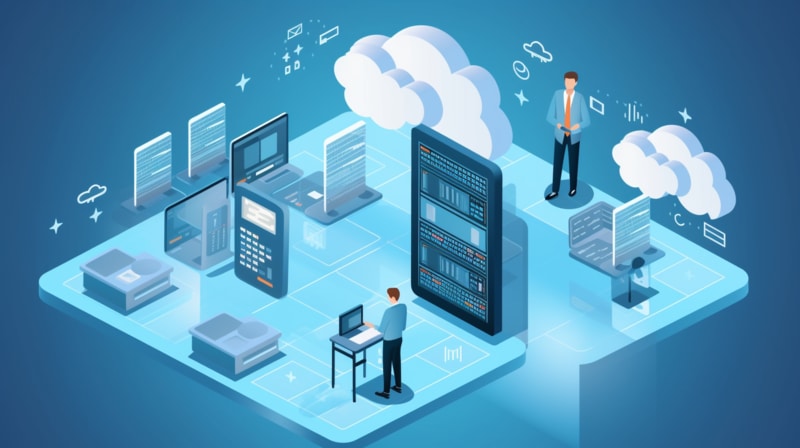AWS EC2 Interview Questions
This blog lists common AWS EC2 Interview Questions!
Amazon Elastic Compute Cloud (EC2) provides scalable cloud computation capabilities with virtual servers which provide fast access and execution times of applications quickly and securely.
Interview Questions on AWS EC2 cover technical issues, best practices, and real world applications of this cloud service platform.
This blog can serve both cloud enthusiasts wanting to expand their knowledge or job seekers preparing for an interview.

1. What is AWS EC2?
AWS EC2 is a compute service that provides secure and reliable add capacity in the cloud. It allows developers to easily integrate with almost all Amazon services and scale up or down infrastructure based on demand while only paying for what they use.
2. How do I create an EC2 instance?
To create an EC2 instance, first create an Amazon Mission Image (AMI) that includes the software and application packages needed to run your application, choose the hardware type based on the workload, configure the instances by specifying the number of cases, subnets, and patch updates, add additional storage and use tags to identify the instance, configure the firewall, and finally click on “Create” to launch the EC2 instance.
3. What are Amazon Machine Images (AMIs)?
Amazon Machine Images (AMIs) are templates that create new instances based on user requirements, including software, operating systems, additional applications, and software information.
4. How do I configure an EC2 instance?
To configure an EC2 instance, choose between spot, reserved, or on-demand instances; configure your instance with various billing options, including public IP errors, IAM roles, and shut-on behaviour; and choose payment options, including average price, reserved instance, and spot instance.
5. What is a keypair in AWS EC2?
A keypair is a set of private and public keys to secure and access an EC2 instance. The private key is kept with the user and connected to the instance, while Amazon uses the public key to confirm the user’s identity.
6. How do you launch a Linux instance using PuTTY?
To launch a Linux instance using PuTTY, first, generate a keypair using PuTTY generator, convert the dot pem file into a ppk format, and save it as a dot ppk type private key.
Then, open PuTTY, enter the IP address, click on auth and choose the private key to connect to the instance. The default username for the AMI is accessible to the hyphen user.
7. What is the difference between Windows and Linux instances in AWS EC2?
The key difference between Windows and Linux instances in AWS EC2 is the launch method.
8. What is a topic in SNS?
A topic in SNS is a way to send and receive notifications between Amazon services. It allows subscribers to receive notifications whenever new content is added to the S3 bucket.
9. What is S3 in AWS?
S3 (Simple Storage Service) is a highly scalable, durable, and secure object storage service that allows you to store and retrieve data from anywhere on the web, including website content, application data, backup and archive data, and more.
10. What is SNS in AWS?
SNS (Simple Notification Service) is a highly scalable, reliable, andfully managed pub/sub-messaging service that allows you to publish and subscribe to topics.
It will also enable you to send and receive notifications between Amazon services, such as EC2 and S3, and other applications like email and SMS.
11. What are the limits for running resources in the AWS cloud?
The limits for running resources in the AWS cloud depend on the instance type and family, but the maximum limit, for instance, running one of the families, is 1,280 vCPUs.
12. What are the networking features in AWS EC2?
AWS EC2 offers various networking features, such as security groups, elastic IPs, availability zones, internet gateways, and load balancers.
Additionally, users can use VPC peering to connect two VPCs over the AWS network and Direct Connect for dedicated network connectivity to AWS.
13. How do I create a new key pair in AWS EC2?
To create a new key pair in AWS EC2, create a new account and download the key pair.
14. How do I connect to an EC2 instance using SSH?
To connect to an EC2 instance using SSH, copy the public IP address to the clipboard, paste it into the key pair file, and use the SSH EC2-user.
15. How do I connect to a Windows instance using RDP?
To connect to a Windows instance using RDP, terminate the Linux instance and use an RDP client to connect to the Windows instance by entering the public IP address of the instance and the administrator username.
16. What happens to the EBS volume when an EC2 instance is terminated?
By default, the EBS volume will be deleted along with the instance when it is terminated, causing data loss.
17. What is a security group in AWS EC2?
A security group is a firewall applied at the instance level that looks for traffic going into and out of elastic interfaces connected to the instance.
18. Can two instances be launched in the web access security group and the SEC security group?
You can launch two instances in these security groups using the Amazon Linux 2 AMI and T2 micro instance type.
19. How do I edit security group rules in AWS EC2?
To edit security group rules, navigate to the security group in the console, click the “Rules” tab, and add or modify the rules as needed.
20. How do youterminate instances in AWS EC2?
To terminate an instance, navigate to the examples in the console, select the instance, click on the “Actions” tab, and choose “Terminate.”

AWS EC2 Training

21. What is EC2 instance user data?
EC2 instance user data is a way to configure system commands and view configured information when launching an instance.
22. How do I configure EC2 instance user data?
To configure EC2 instance user data, go to the “Advanced Details” section when launching an instance and enter the user data in the “User Data” field.
23. What is a cloud watch alarm in AWS?
A cloud watch alarm is a service used for monitoring operational information using metrics collected from AWS services.
24. How do you create a cloud watch alarm?
To create a cloud watch alarm, navigate to the CloudWatch console, click on the “Alarms” tab, and follow the steps to create a new alarm.
25. What is the difference between a public IP address and an elastic IP address in AWS EC2?
The difference is that the elastic IP address is static and can be moved between instances and network adapters.
In contrast, the public IP address is always associated with a private IP address on the instance and is used in public subnets.
26. How do I create an elastic IP address in AWS EC2?
To create an elastic IP address in AWS EC2, go to the “Elastic IPs” section under “Network and Security” and choose “Allocate New Address.” This will create a static public IP address associated with the instance.
27. Which AWS service can a business use for storing content and setting up notifications for new data?
S3 for storage with notifications managed by SNS (Simple Notification Service).
28. How do I release elastic IPs in AWS EC2?
To release an elastic IP in AWS EC2, go to the “Elastic IPs” section under “Network and Security” and choose “Dissociate.” This will release the elastic IP address and be available for re-use. Wait until the instance shuts down before removing the addresses.
29. How do I create a private subnet in AWS VPC?
To create a private subnet in AWS VPC, go to the “Subnets” section under “Virtual Private Cloud” and click on “Create Subnet.”
Select the VPC where you want to create the subnet, choose an availability zone, and configure the subnet’s IP address range.
30. What does NATstand for in AWS EC2?
NAT stands for Network Address Translation.
31. How do I create a NAT gateway in AWS EC2?
To create a NAT gateway in AWS EC2, go to the “NAT Gateways” section under “Network and Security” and click on “Create NAT Gateway.”
Select an existing public subnet and choose a shared IP address for the NAT gateway.
32. What are the two types of AMIs available in AWS EC2?
Predefined AMIs (Amazon-provided AMIs) and custom AMIs (custom AMIs).
33. How do I enable internet connectivity, for instance, in a private subnet?
To enable internet connectivity for instances in a private subnet, create a route table entry for the NAT gateway and add a rule to allow all outbound traffic. Remove the ICP rule for internet-facing instances and terminate existing cases in the public subnet.
34. What is a NAT instance in AWS EC2?
A NAT instance is an EC2 instance that translates private IP addresses to public IP addresses, allowing instances in private subnets to communicate with the internet. NAT instances can be configured with port forwarding for manual customisation.
35. How do I create a NAT instance in AWS EC2?
To create a NAT instance in AWS EC2, go to the “Instances” section in the console and select “Launch Instance.” Choose an Amazon Linux AMI and configure the instance settings. In the “Instances” details page, add a route table entry that points to the NAT instance for any IP address destinations outside the VPC. Enable port forwarding for the NAT instance to function as a NAT instance.
36. How do I connect to a private subnet instance using agent forwarding from a Windows PC?
To connect to a private subnet instance using agent forwarding from a Windows PC, use SSH (Secure Shell) from a Windows PC and connect to the jump host.
Then, connect to the private instance using agent forwarding from the Windows PC. You do not need to specify a key pair to connect to the remote instance.
37. What are clusters in AWS?
Clusters are used to place instances into low-latency groups within a single A-Z, resulting in low network latency and high throughput. They can be created using an enhanced network adapter or partition placement group.
38. What are partitions in AWS?
Partitions are logical segments in AWS that group instances into logical segments, each using distinct hardware. This control over instance placement reduces the likelihood of correlated failures, ensuring the application stays running even if multiple racks go down in AWS.
39. How do I create a placement group in AWS?
To create a placement group in AWS, go to the “Placement Groups” section in the EC2 console and click “Create Placement Group.”
Choose the type of placement group you want to create (cluster, partition, or spread) and specify the number of partitions. When launching an instance, select the placement group you wish to use.
40. What is a spread placement group in AWS?
A spread placement group in AWS spreads instances across distinct underlying hardware, providing resiliency as each rack has its redundant power networking. This reduces the risk of simultaneous instance failure.
41. What is an enhanced network adapter (ENA) in AWS?
An enhanced network adapter (ENA) in AWS provides enhanced performance and scalability for network-intensive workloads. It can also create clusters and partition placement groups.

AWS EC2 Online Training

42. What service does AWS EC2 provide to developers?
AWS EC2 provides secure and reliable computing capacity in the cloud, allowing developers to scale their infrastructure based on demand.
43. What type of service is EC2 considered to be within the AWS ecosystem?
EC2 is a web service providing scalable computing capacity in the cloud.
44. What steps are involved in setting up an AWS EC2 instance?
Setting up an EC2 instance involves creating an Amazon Mission Image (AMI), choosing a hardware type, configuring instances, adding storage, tagging, configuring the firewall, and launching the instance.
45. What instance types can be chosen when creating an EC2 instance?
Instance types include computer-optimized, memory-optimized, GPU-optimized, storage-optimized, and general-purpose.
46. How can storage be added to an AWS EC2 instance?
Storage can be added through ephemeral storage, external elastic block storage (EBS), or by integrating EC2 with S3.
47. What is a ‘key pair’ in AWS EC2, and why is it important?
A ‘key pair’ consists of a public and private key used for secure access to EC2 instances. The user downloads the private key, while Amazon uses the public key to confirm the user’s identity.
48. What are the security measures for an EC2 instance to control access?
Security measures include creating security groups that act as a virtual firewall and controlling access based on port numbers and IP addresses.
49. What should a user do before an EC2 instance launches in the AWS console?
A user should create and configure a ‘key pair’ to ensure they can securely connect to the EC2 instance once launched.
50. What purposes do placement groups serve in Amazon EC2?
Placement groups dictate how EC2 instances are physically positioned within an AWS data centre to meet specific networking and other requirements.
51. What types of volumes can be selected as additional storage in AWS EC2?
Users can select storage types, including solid-state drive (SSD) and magnetic storage, with options for encrypting the volume.

The MCQs will test your knowledge and critical thinking on pertinent topics.
1. What is Amazon EC2 primarily used for?
a)
b) Data storage
c) Messaging service
d) Content delivery network
2. Which AWS services can be used to advertise and notify products to customers?
a) IAM
b)
c) VPC
d) EC2
3. What type of AMIs can users choose to create new EC2 instances?
a) Standard AMIs and modified AMIs
b)
c) Fixed AMIs and flexible AMIs
d) Public AMIs and private AMIs
4. How can AWS users reduce costs on their computing capacity?
a) Creating custom AMIs
b)
c) Selecting SSD storage
d) Opting for advanced networking
5. When provisioning an EC2 instance, what is recommended for additional storage?
a) Internal memory optimisation
b)
c) High availability setups
d) Container storage solutions
6. What kind of computing environment does EC2 provide?
a) Local, closed and static
b) Desktop-oriented, private and fixed
c) Manual, isolated and physical
d)
7. Which of the following information can the ‘curl’ command provide about an EC2 instance?
a)
b) Amazon’s annual revenue data
c) A list of AWS staff administrators
d) Global configuration history
This AWS EC2 Interview Questions and Answers blog contains some of the most frequently asked and significant EC2 interview questions, which should help prepare you for an upcoming job interview.
After reading, we hope you have gained more of an understanding of AWS EC2 and its possibilities and are ready to use this service to advance your company.
In order to be successful with cloud computing as a profession, continue learning more and exploring AWS EC2, staying updated with recent advancements.
Wishing you luck.

AWS EC2 Course Price


Ankita
Author